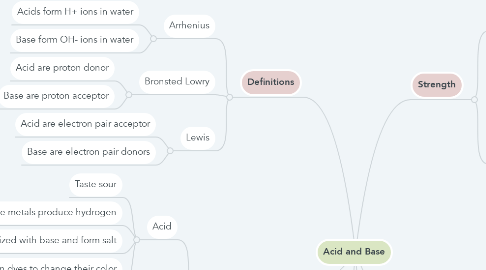
1. Properties
1.1. Acid
1.1.1. Taste sour
1.1.2. React with some metals produce hydrogen
1.1.3. Neutralized with base and form salt
1.1.4. make certain dyes to change their color
1.2. Base
1.2.1. Taste bitter
1.2.2. Be use to wash off grease
1.2.3. Neutralize with acid and form salt
1.2.4. make certain dyes to change their color
2. Definitions
2.1. Arrhenius
2.1.1. Acids form H+ ions in water
2.1.2. Base form OH- ions in water
2.2. Bronsted Lowry
2.2.1. Acid are proton donor
2.2.2. Base are proton acceptor
2.3. Lewis
2.3.1. Acid are electron pair acceptor
2.3.2. Base are electron pair donors
3. Uses in daily life
3.1. Acid
3.1.1. Lemon juice
3.1.1.1. Citric Acid
3.1.2. Vinegar
3.1.2.1. Acetic acid
3.1.3. Curd
3.1.3.1. Lactic acid
3.1.4. Ants salive
3.1.4.1. Formic acid
3.1.5. Pepsi
3.1.5.1. Carbonik acid
3.2. Base
3.2.1. Toothpaste
3.2.1.1. Sodium carbonate
3.2.2. Baking soda
3.2.2.1. Sodium bicarbonate
3.2.3. Alkaline batteries
3.2.3.1. Potassium hydroxide
3.2.4. Disinfectant
3.2.4.1. Calcium hypoclorite
3.2.5. Agricultural fertilizer
3.2.5.1. Ammonia
4. Strength
4.1. Acid
4.1.1. Ka =[H3O+][A-]/[HA]
4.1.1.1. Weak Acid
4.1.1.1.1. Dissociated partially in water to form H+
4.1.1.1.2. The smaller Ka, the weaker its acidity
4.1.1.2. Strong Acid
4.1.1.2.1. Totally dissociated in water to form H+
4.1.1.2.2. The bigger Ka, the stronger its acidity
4.1.2. pH = -log [H+]
4.2. Base
4.2.1. Kb= [BH+][OH-]/[B]
4.2.1.1. Weak Base
4.2.1.1.1. Dissociated partially in water to form OH-
4.2.1.1.2. The smaller Kb, the weaker its basidity
4.2.1.2. Strong base
4.2.1.2.1. Totally dissociated in water to form OH-
4.2.1.2.2. The bigger Kb, the stronger its basidity
4.2.2. pOH = -log [OH-]
5. Neutralization
5.1. Strong Acid- Strong Base
5.1.1. pH=7
5.2. Weak acid - strong base
5.2.1. pH > 7
5.3. Strong acid- weak base
5.3.1. pH < 7
5.4. Weak acid-weak base
5.4.1. pH = 7 if Ka = Kb
5.4.2. pH > 7 if Ka < Kb
5.4.3. pH < 7 if Ka > Kb
5.5. Reaction between acid and base which produce salt and water
6. Titration
6.1. Titrant
6.1.1. The standardized (known) solution
6.2. Analyte
6.2.1. The unknown solution whose concentration is being determined called
6.3. Equivalence point
6.3.1. When titrant's moles are stochiometrically equal to the sample.
6.4. Indicators
6.4.1. phenolphthalein indicator
6.4.2. Bromthymol blue
6.4.3. Methyl red
6.4.4. Methyl Orange
6.5. Analytical calculation
6.5.1. Ca = Ct.Vt.M/Va
6.6. Used to
6.6.1. Determines concentration of an acid/base by neutralizing

